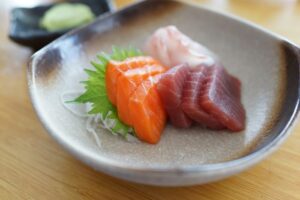
News flash: Sashimi and sushi are not the same thing.
Simply put, it’s raw fish. But it’s not just raw fish—freshness, quality, and cut matter.
Since it’s served raw, sashimi is made with very high-quality fish. That’s as much for your taste buds as your health. Poor-quality fish, or fish that isn’t prepared properly, can make you sick. Doctors have reported cases of parasitic infections (aka worms) in people who have eaten raw sushi. That’s why good sashimi fish (often tuna, yellowtail, mackerel, and salmon) are caught, iced, and used all in rapid succession. It’s also why you should skip the sashimi and sushi at all-you-can-eat buffets.
You can find sashimi-grade fish at your supermarket, but be careful in selecting it to be sure it’s high enough quality. Previously frozen fish is your best bet, but don’t be shy about asking the fishmonger for advice. You might intend on making tuna sashimi but learn the salmon is especially fresh that morning.
While people are generally referring to raw fish when they talk about sashimi, you may also come across beef or pork sashimi. With those types of sashimi, you’ll also want to make sure the meat is as fresh as possible.
I – Word Understanding
Fishmonger – someone who sells raw fish and seafood
II – Have Your Say
1, Explain the following:
a, Sashimi vs. sushi
b, Nigiri vs maki
2, Are you fond of dining at “all-you-can-eat buffets”? Why is it better to skip sashimi and sushi in buffets? Where is the best place to have sashimi and sushi?
3, Raw fish, raw beef, raw pork, even raw horse meat! Why do Japanese people love raw meat? Is it one of Japan’s secrets to long life?


